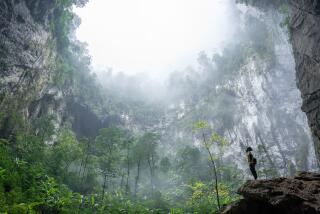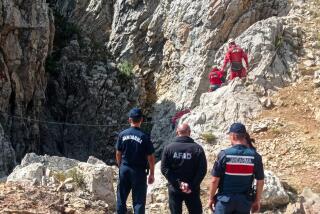Explorers Plan Trip Deep Into the Earth
- Share via
MEXICO CITY — A dozen explorers plan a Jules Verne journey into the bowels of the Earth, beginning with a descent of nearly a mile in a marble-walled cave along a thundering subterranean river.
The journey, a claustrophobe’s nightmare, will take the explorers into a dark, underground world for weeks at a time.
In an emergency, someone would need 24 hours to carry a message to the surface. Radios are useless underground.
After descending 4,439 feet, Maryland engineer William Stone and his team hope to dive through a pool that blocks the rest of the cave, emerging in a dry passage somewhere beyond.
They plan to start in late February or early March, when Mexico’s dry season makes the flood-prone cave passable.
Success could carry them deeper into the Earth than anyone has ever gone. It also would help reveal the extent of the Huautla caves 170 miles southeast of Mexico City.
“It’s probably the largest vertical cave system in the world,” said Nicholas Sullivan, president of the Explorers Club of New York, a sponsor of the trip.
Explorers have spent more than a decade probing the cave system from two entrances and swam through subterranean pools in places. But they were eventually frustrated by the problems of hauling along heavy air tanks and supplies and the time limits imposed on divers by conventional tanks.
Stone, 38, spent years designing and building a breath-recycling device, still experimental, that will lighten the load and let divers stay in the water hours longer. He is an engineer with the National Institute of Standards and Technology, and hopes to market the technology for use on space flights.
The cave entrance is in a forest of evergreens. The explorers’ aim is to emerge eventually through an opening in a tropical jungle nearly 5,400 feet lower and 11 surface miles away.
To reach the pool blocking their path, explorers following the light of carbolic lamps must use rock-climbing techniques to edge down a serpentine marble cave polished smooth by the roaring river below their feet.
“It’s deafening,” Stone said. “You’ve got all of the water coming down the canyon, and it’s ricocheting off the walls, and you can actually feel the walls vibrate.”
“It’s a real spooky place.”
A Mexican member of the team, chemical engineer Angel Soto Porrua, insisted that cave diving is not especially dangerous but added: “It’s very sure you will die if you don’t follow the instructions.”
Earlier this year, a member of a preliminary expedition apparently slipped while deep inside the cave and fell to his death.
Some team members will spend six weeks at a time underground, camped in a chamber as long as three football fields and 18 stories high, living on powdered, freeze-dried food packed into waterproof jugs.
If something goes wrong, Stone said, a climber might be able to “blitz” to the surface with a message in 24 hours.
Once past the pool, Stone said, “if you have any kind of serious trouble . . . you’re going to have to deal with it yourself. It’s just like going to the moon for the first time. It’s you and your machine.”
Claustrophobia should be no problem for his team of experienced spelunkers, he said. NASA has expressed interest in testing them to see how they cope with long periods of arduous work side by side, out of touch with the outside world, he added.
Stone and other divers have been probing both ends of the Huautla system since 1979. Flooded portions have kept them out of an unexplored gap of about 3.7 miles, he said, and “you can multiply that by a minimum factor of two” because of likely twists and turns.
On the other side of the water is “a big question mark,” but the cave might connect with another major system that has an entrance 18 miles away, Stone said.
“We could be into a maze of galleries the likes of which few people have ever found,” he said.
More to Read
Sign up for Essential California
The most important California stories and recommendations in your inbox every morning.
You may occasionally receive promotional content from the Los Angeles Times.













